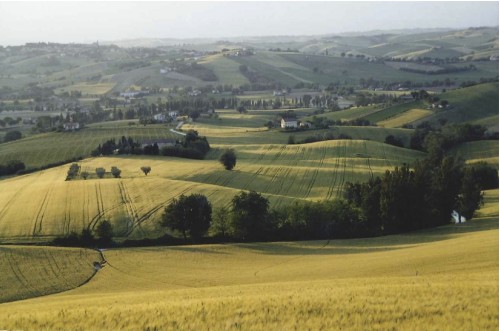A Closer Look at Bucci’s Global Warming Tactics

Ampelio Bucci has long enjoyed leading the pack in the making of quality – and especially age-worthy – white wines as well as deliciously inviting reds. In decades past, he was responsible for adding cellarable, oak-aged white wines, made from a native Marche grape no one believed could stand up to the world’s best, to Italy’s long list of – mostly red – excellences. In fact, the longtime marketing expert built his winemaking empire on challenging many Italian enological tenets, but also by carrying out frequent experiments.
The Bucci family has been in the agricultural business, cultivating soft and hard wheat, corn, sugar beets, and much more in Italy’s Le Marche region, an unspoiled area of central Italy, close to the coast and the mountains, for centuries. When it came time to plant vineyards, Ampelio and his team scoured the countryside to find the best vineyards with the soils – specifically limestone and clay, which retains humidity, fosters good health, and lends minerality to the wines – altitudes and exposures that are most suitable to the making of elegant, complex wines. Settling on six different parcels, Ampelio increased his workload and costs – six vineyards meant six separate harvests, six separate vinifications, and six different wines that he could blend to achieve his perfect style. Ampelio started with the Marche native Verdicchio to promote the unique patrimony of the region, distinctively suited to the local terroir in a way that “foreign” grapes may not have been. He also planned for smaller yields – about half what the DOCG regulations allowed – a ‘sacrifice’ Ampelio was willing to make for higher quality.
VILLA BUCCI AND CLIMATE CHANGE
Agriculture and viticulture see the effects of global warming from the front lines. In fact, over the past forty years, Bucci has seen the climate go from temperate to scorching hot, which leads to earlier yearly harvests and high-alcohol wines. Ampelio began making changes, not just to “survive” the inevitable variations, but to maintain elegant, balanced wines. In a few words, Ampelio sums up his philosophy: “We believe in the long life of the plant.” Explaining that, “The roots of old vines dig deep into the soil looking for humidity and cooler temperatures. This is one way the plant is protected against the inevitable warming of the planet. Everything we do is to increase the life of the plant (organic cultivation, ‘surgical’ pruning, planting in limestone, etc.). Healthy vines live longer and give us better quality grapes, thus wines.”
Some of Bucci’s experiments have turned into everyday practice and have helped shape the company’s entire way of thinking.
- Bucci has been organic for over twenty years, with official certification in 2000. The idea is to grow healthy grapes ethically, even if the quantity is reduced. To make a good wine, you need perfect grapes. Only then can you begin to talk about the quality of your wine.
- Bucci only plants in limestone and clay to ensure excellent water reserves. Clay tends to hold water better and the roots of the vines dig deep in search of water, leading to less need of irrigation and less chance of scorching.
- Bucci does not always plant facing south. While that has always been considered the best aspect for vineyards, in an increasingly blisteringly hot climate, perhaps a bit less sun could be indicated. Hence, some of the vineyards face north or east.
- Bucci uses special soil looseners that essentially aerate and de-compact the soil. This encourages deep root growth and increases moisture intake, fostering the production of quality grapes over the long term.
- Bucci created its own nursery to cultivate its own clones that, in their experience, are more resistant to the microclimate and ever-increasing heat. The winery began planting only their clones all the way back in 2000.
- Having discovered that the vines with the deepest roots best survive the increase in temperatures, Bucci dedicated itself to perfecting and increasing the life of its old vines through a special type of pruning. The idea is to leave the “living” part of the vines untouched and do very “small cuts” on the dead parts to decrease desiccated areas and allow fluidity in the plant’s vascular flow.
Ampelio maintains that since 2003, global warming in the Marche became much more apparent so his winery has been doing various experiments to combat the phenomenon:
- Bucci is pruning later to attempt to shorten the cycle by a few weeks.
- Bucci is exposing the tiny grape bunches during flowering to get them used to the hot spring sun, in hopes they will withstand the summer heat better.
- Bucci is allowing the foliage to grow longer so it can provide the grapes with shade for at least part of the day. In fact, they built small bower-like structures that would gently drape the leaves over the grapes.
- Bucci is spraying a light film of kaolin or bentonite over the grapes to create a protective layer. N.B. It is washed off or falls off when the weather is dry so it does not go into the wine.
Always the innovator, what sets Bucci apart is a constant desire to grow and evolve with the changing times. Ampelio never rests on his laurels and knows that perfection in the grape-growing, winemaking world requires constant attention, research, experimentation and hard work. Things the venerable winemaker has never shied away from.